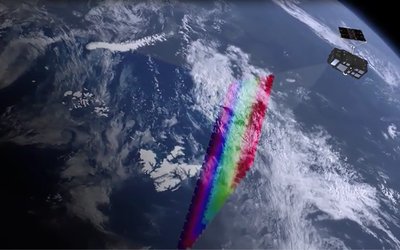Accept all cookies Accept only essential cookies See our Cookie Notice

About ESA
The European Space Agency (ESA) is Europe’s gateway to space. Its mission is to shape the development of Europe’s space capability and ensure that investment in space continues to deliver benefits to the citizens of Europe and the world.
Highlights
ESA - United space in Europe
This is ESA ESA facts Member States & Cooperating States Funding Director General Top management For Member State Delegations European vision European Space Policy ESA & EU Space Councils Responsibility & Sustainability Annual Report Calendar of meetings Corporate newsEstablishments & sites
ESA Headquarters ESA ESTEC ESA ESOC ESA ESRIN ESA EAC ESA ESAC Europe's Spaceport ESA ESEC ESA ECSAT Brussels Office Washington OfficeWorking with ESA
Business with ESA ESA Commercialisation Gateway Law at ESA Careers Cyber resilience at ESA IT at ESA Newsroom Partnerships Merchandising Licence Education Open Space Innovation Platform Integrity and Reporting Administrative Tribunal Health and SafetyMore about ESA
History ESA Historical Archives Exhibitions Publications Art & Culture ESA Merchandise Kids Diversity ESA Brand Centre ESA ChampionsLatest
Space in Member States
Find out more about space activities in our 23 Member States, and understand how ESA works together with their national agencies, institutions and organisations.
Science & Exploration
Exploring our Solar System and unlocking the secrets of the Universe
Go to topicAstronauts
Missions
Juice Euclid Webb Solar Orbiter BepiColombo Gaia ExoMars Cheops Exoplanet missions More missionsActivities
International Space Station Orion service module Gateway Concordia Caves & Pangaea BenefitsLatest
Space Safety
Protecting life and infrastructure on Earth and in orbit
Go to topicAsteroids
Asteroids and Planetary Defence Asteroid danger explained Flyeye telescope: asteroid detection Hera mission: asteroid deflection Near-Earth Object Coordination CentreSpace junk
About space debris Space debris by the numbers Space Environment Report In space refuelling, refurbishing and removingSafety from space
Clean Space ecodesign Zero Debris Technologies Space for Earth Supporting Sustainable DevelopmentLatest
Applications
Using space to benefit citizens and meet future challenges on Earth
Go to topicObserving the Earth
Observing the Earth Future EO Copernicus Meteorology Space for our climate Satellite missionsCommercialisation
ESA Commercialisation Gateway Open Space Innovation Platform Business Incubation ESA Space SolutionsLatest
Enabling & Support
Making space accessible and developing the technologies for the future
Go to topicBuilding missions
Space Engineering and Technology Test centre Laboratories Concurrent Design Facility Preparing for the future Shaping the Future Discovery and Preparation Advanced Concepts TeamSpace transportation
Space Transportation Ariane Vega Space Rider Future space transportation Boost! Europe's Spaceport Launches from Europe's Spaceport from 2012Latest
Sentinel-3’s scanning radiometer
Thank you for liking
You have already liked this page, you can only like it once!
The Sentinel-3 satellites carry a package of different instruments including the Sea and Land Surface Temperature Radiometer (SLSTR). This instrument measures global sea- and land-surface temperatures every day to an accuracy of better than 0.3 K. Continuing the legacy of Envisat’s Advanced Along Track Scanning Radiometer, it maintains a dual-view along-track-scanning approach and delivers measurements at a spatial resolution of 500 m for visible/near-infrared and short-wavelength infrared channels and at 1 km for the thermal infrared channels. Furthermore, SLSTR includes two dedicated thermal infrared channels that are optimised for active fire detection and fire radiative power measurement – important for Copernicus Emergency Response and Climate Services.
The animation shows how SLSTR’s two rotating mirrors scan a curved swath on the ground, one at nadir and one inclined obliquely pointing to the rear of the satellite. The oblique view has a narrower swath of 740 km compared to 1400 km of the nadir swath. As each scanner rotates, it samples signals in nine separate bands covering the visible and infrared part of the electromagnetic spectrum, indicated by the colours rising towards the satellite. As the satellite orbits, the dual-view technique is used to improve atmospheric correction and generate more accurate data products compared to a nadir view alone.
-
CREDIT
ESA/ATG medialab -
LICENCE
ESA Standard Licence
-
Animation
-
-
-
-

Sea and Land Surface Temperature Radiometer: technical view

Europe viewed wide

Islands in red

Ice cracked















 Germany
Germany
 Austria
Austria
 Belgium
Belgium
 Denmark
Denmark
 Spain
Spain
 Estonia
Estonia
 Finland
Finland
 France
France
 Greece
Greece
 Hungary
Hungary
 Ireland
Ireland
 Italy
Italy
 Luxembourg
Luxembourg
 Norway
Norway
 The Netherlands
The Netherlands
 Poland
Poland
 Portugal
Portugal
 Czechia
Czechia
 Romania
Romania
 United Kingdom
United Kingdom
 Slovenia
Slovenia
 Sweden
Sweden
 Switzerland
Switzerland


























